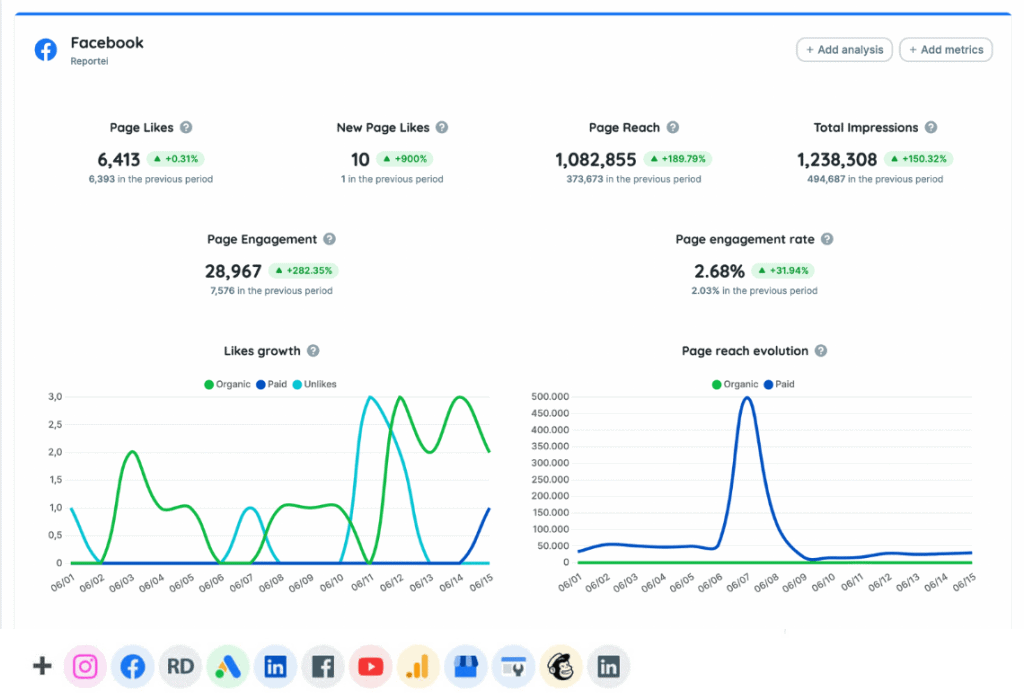
Social media platforms have emerged as powerful tools for businesses to engage with their audience, increase brand awareness, and drive sales. As social media usage continues to grow, businesses must harness the power of analytics to measure the effectiveness of their social media efforts, make data-driven decisions, and optimize their strategies.
In this article we’ll be breaking down the importance of social media analytics, the meaning of all those terms you’ve heard, performance measurement, and what key metrics and best practices to follow.
Importance of Social Media Analytics
Social media analytics is the process of gathering, analyzing, and interpreting data from social media platforms to understand audience behavior, measure the success of campaigns, and optimize marketing strategies.
To effectively utilize social media analytics and make data-driven decisions, it is crucial for businesses to understand the common terms and metrics used in this field.
Conversion Rate
The conversion rate measures the percentage of users who take a desired action after engaging with your social media content. Conversions can include actions such as visiting your website, signing up for a newsletter, or making a purchase. Tracking conversion rates is crucial for evaluating the effectiveness of your social media campaigns in driving specific actions and generating a return on investment (ROI).
Engagement Rate
The engagement rate is a metric that assesses how users interact with your social media content. It is calculated by dividing the total number of interactions (likes, comments, shares, retweets, etc.) by the total number of followers (or impressions) and multiplying by 100 to get a percentage. A higher engagement rate indicates that your content resonates with your audience and encourages interaction.

Impressions
Impressions represent the total number of times your content has been displayed on a social media platform, regardless of whether it was clicked or interacted with. Impressions provide insight into the visibility and potential reach of your social media content. Tracking impressions can help you understand the effectiveness of your content in capturing users’ attention.
Reach
Reach refers to the number of unique users who have seen your content on a social media platform. Unlike impressions, reach only counts a user once, no matter how many times they were exposed to your content. Reach is a valuable metric for understanding the potential audience size and the overall visibility of your social media campaigns.
CPM (Cost Per Mile)
CPM, or cost per mile, is a metric used to measure the cost of 1,000 impressions of an advertisement on a social media platform. It is commonly used in paid social media advertising to evaluate the cost-effectiveness of a campaign. A lower CPM indicates that your ad is reaching more people at a lower cost, which is particularly useful when comparing the performance of different ad placements or targeting strategies.
CPC (Cost Per Click)
CPC, or cost per click, is a metric used to measure the cost of each click generated by a social media advertisement. CPC is a critical metric in paid social media advertising, as it helps businesses understand the cost-effectiveness of their ads and optimize their campaigns to achieve better results at a lower cost. Lower CPC values indicate a more cost-effective campaign, while higher CPC values suggest that there is room for optimization or targeting improvements.
Click-Through Rate (CTR)
Click-through rate (CTR) is the percentage of users who click on a link or advertisement after viewing it. It is calculated by dividing the total number of clicks by the total number of impressions and multiplying by 100 to get a percentage. A higher CTR indicates that your content or ads are capturing users’ attention and driving them to act. Tracking CTR can help businesses assess the effectiveness of their ad creative, targeting, and overall campaign strategy.
Once we have a solid understanding of the terms and metrics, it’s time to put them to use in translating and interpreting data.

Performance Measurement
Social media analytics enables businesses to measure the performance of their social media campaigns, assess the return on investment (ROI) of their marketing efforts, and determine which strategies are most effective. By tracking key performance indicators (KPIs), businesses can identify their strengths and weaknesses, allowing them to make informed decisions about allocating resources and adjusting their social media strategies.
Audience Insights
Analyzing social media data allows businesses to gain valuable insights into their audience, such as demographics, preferences, behaviors, and sentiments. These insights can help businesses better understand their target audience, tailor their content to resonate with their followers, and create more personalized and engaging experiences.
Competitive Analysis
Social media analytics also enables businesses to monitor their competitors and gather insights into their social media strategies, strengths, and weaknesses. By benchmarking their performance against competitors, businesses can identify gaps in their social media strategy and uncover opportunities for growth.
Crisis Management
By keeping a close eye on social media conversations, businesses can quickly identify and respond to potential issues, such as negative customer feedback, product issues, or reputational risks. Timely and appropriate responses to these issues can help businesses protect their brand image, maintain customer trust, and mitigate potential crises.

Key Social Media Metrics
To effectively utilize social media analytics, businesses must track the right metrics. While the specific metrics to monitor may vary depending on a business’s goals and objectives, some common metrics include:
Key Areas to Monitor
In social media analytics, businesses should focus on the following key areas to track their performance and make data-driven decisions:
- Engagement Metrics: Track likes, comments, shares, and other interactions to gauge the resonance of your content with your audience.
- Reach and Impressions: Monitor the visibility and potential audience size of your social media campaigns to evaluate overall exposure.
- Follower Growth: Assess the increase or decrease in your social media audience size over time to understand your brand’s performance on different platforms.
- Conversion Rate: Measure the effectiveness of your social media campaigns in driving specific actions and generating ROI.
- Sentiment Analysis: Examine the emotions and opinions expressed by users in social media conversations related to your brand, products, or services.
Interpreting Sample Data and Strategies for Improvement
- Low Engagement Rates: If your content consistently receives low engagement, it may not be resonating with your audience. To improve, consider revising your content strategy to better align with your audience’s interests, experimenting with different content formats, and posting at optimal times to maximize visibility.
- Limited Reach and Impressions: If your reach and impressions are low, your content may not be gaining enough exposure. To increase these metrics, consider amplifying your content through paid promotions, collaborating with influencers, or leveraging popular hashtags and keywords to improve discoverability.
- Stagnant or Declining Follower Growth: If your follower count is stagnant or declining, it may indicate that your brand is not attracting new users or retaining existing ones. To address this, re-evaluate your content strategy, engage with your audience more actively, and consider running targeted follower growth campaigns.
- Low Conversion Rates: If your social media campaigns generate low conversion rates, they may not be effectively driving the desired actions. To improve, consider refining your targeting strategy, optimizing your calls-to-action, or testing different ad creatives and landing pages to identify the most effective approach.
- Negative Sentiment: If sentiment analysis reveals predominantly negative feedback, it is essential to address the underlying issues promptly. Respond to customer concerns, resolve product or service issues, and proactively communicate improvements to rebuild trust and enhance brand perception.

Best Practices to Follow
To maximize the benefits of social media analytics, businesses should adopt the following best practices:
Set Clear Goals
Before diving into social media analytics, it is crucial for businesses to establish clear goals and objectives for their social media campaigns. These goals may include increasing brand awareness, driving website traffic, generating leads, or boosting sales. Having well-defined goals will enable businesses to select the appropriate metrics to track and measure the success of their social media efforts.
Monitor Metrics Regularly
Consistent monitoring of social media metrics is essential for understanding how your audience engages with your content and how your social media strategy is performing. Regular monitoring allows businesses to identify trends, uncover opportunities, and address issues in a timely manner. By tracking metrics over time, businesses can establish benchmarks, set realistic targets, and measure their progress towards their goals.
Analyze and Interpret Data
Merely collecting social media data is not enough; businesses must analyze and interpret the data to draw meaningful insights. This involves examining the data for patterns, trends, and correlations that can inform decision-making and strategy optimization. It is essential to consider the context in which the data is collected and any external factors that may influence the results to avoid misinterpretation.
Test and Optimize
Social media analytics provides valuable insights that can be used to test and optimize your social media strategy. Businesses should conduct A/B testing to determine the most effective types of content, posting times, or targeting methods. By continually testing and refining their social media campaigns based on the insights gleaned from analytics, businesses can improve their performance and maximize their ROI.
Use the Right Tools
There is an abundance of social media analytics tools available that can help businesses collect, analyze, and visualize their social media data. Some popular tools include Google Analytics, Hootsuite, Sprout Social, and Buffer. Choosing the right tool for your business depends on your specific needs, budget, and the platforms you are active on. Investing in a reliable and user-friendly analytics tool can streamline the process of data collection and analysis, allowing businesses to focus on using the insights to drive their social media strategy.
Train and Empower Your Team
To fully leverage the power of social media analytics, it is essential to train your team in using analytics tools, interpreting data, and making data-driven decisions. Empower your team to actively monitor and analyze social media metrics and encourage them to share insights and collaborate on strategy optimization. Fostering a data-driven culture within your organization will ensure that your social media efforts are continually informed by analytics.
Social media analytics are an indispensable tool for businesses looking to excel in the digital landscape. Investing in social media analytical tools and fostering a data-driven approach to social media management will undoubtedly yield long-term benefits for businesses in the increasingly competitive online environment.
If you are looking to partner with a social media team for your next strategy or campaign, give us a call – we’d love to chat!
Liked this article?
We are adding more useful articles to our blog every week! Join our subscribers to stay up to date on digital security, marketing, and social media trends.
By entering your email, you agree to receive our monthly newsletter. You can unsubscribe at any time!


